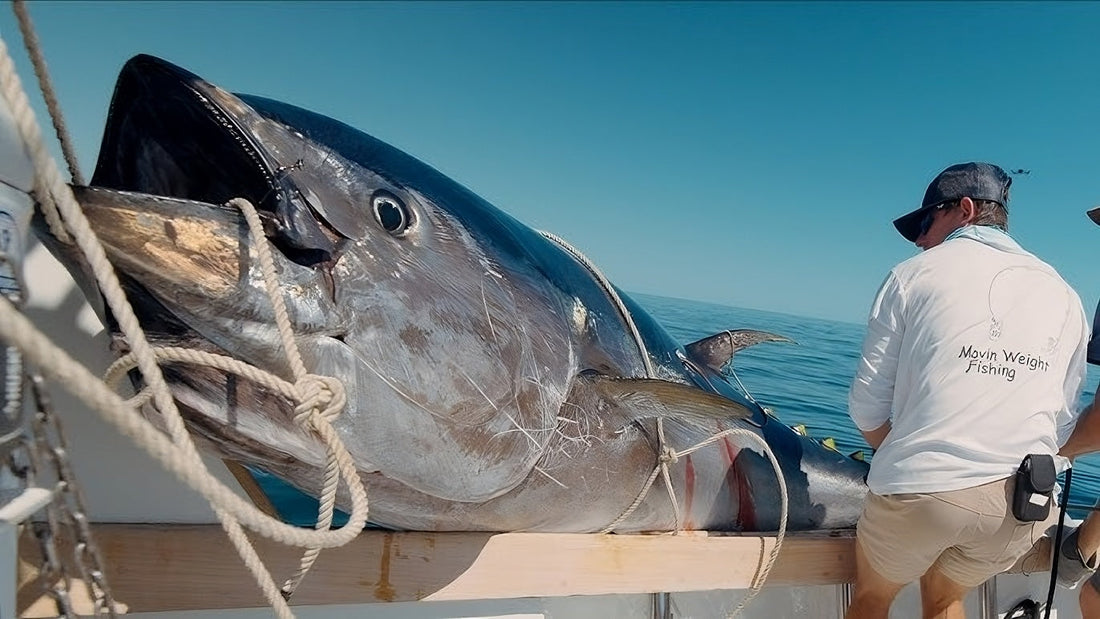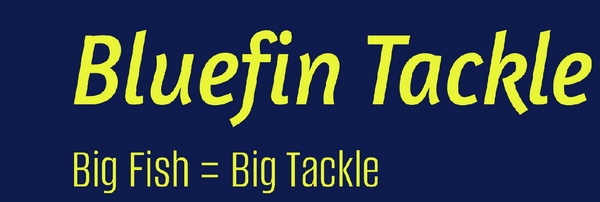
Bluefin Tuna Fishing Rod Guides
Share
The best fishing rod guides for bluefin tuna fishing — a complete 2,000-word guide
Bluefin tuna are brutal. They run hard, they slam lures, and they generate enormous heat and abrasion on your line. Choosing the right rod guides for a bluefin outfit is not a cosmetic decision — it’s a reliability, safety, and performance decision. The right guides protect your line from abrasion and heat, keep line flow smooth under extreme drag, and withstand the shock and punishment of heavy saltwater use. This article walks through what matters for bluefin tuna guides, which materials and frame styles to favor, the top guide brands and models to consider, guide layout tips for tuna rods, and maintenance practices that keep your guides fighting-fit.
What bluefin tuna demand from rod guides
Before we pick brands and models, let’s be explicit about the stresses a bluefin tuna rod guide must survive:
1. High friction & heat — long runs under heavy drag produce heat where line rubs the ring. That can weaken or melt some lines if the ring material and thermal conductivity are inadequate.
2. Abrasive braided lines — most tuna anglers use braid or heavy-covered braid (e.g., braid with mono/fluorocarbon leader). Braid is very abrasive and will wear rings that aren’t up to the task.
3. Impact & shock — sloppy drops, hitting the rod on gunnels, or a fish thrashing can deform or crack guide frames or inserts.
4. Corrosion & salt — constant exposure to saltwater plus grit means frame material and finishes must resist pitting or binding.
5. Load distribution — under extreme bending loads the guide must stay seated and aligned; double-foot frames and robust foot shapes help distribute load to the blank.
A guide that handles these stresses will protect your line, preserve the blank, and save you from losing fish and expensive tackle.
Best materials for bluefin guides
Two material decisions dominate the discussion: frame material and ring insert material.
Frame material: stainless steel (316/316L), titanium, and coatings
* 316L stainless frames are the industry standard for heavy boat guides. They’re robust, readily available, and when properly finished or PVD/PVD-like coated resist saltwater corrosion very well. Many heavy-duty guides use 316L frames for sheer toughness.
* Titanium frames offer the same or greater strength while shaving weight and offering absolute corrosion immunity — they’re premium, but for long rods or when every gram matters, they’re worth considering.
* Coatings / finishes (Fuji’s Corrosion Control or PVD coatings used by SeaGuide, PacBay, etc.) add an extra layer of protection and can reduce galvanic issues when mixed with different reel metals. Sources and vendors often recommend titanium or high-quality stainless with corrosion finishes for offshore bluewater use.
Ring inserts: SiC, Alconite, zirconia, and advanced ceramics
* Silicon Carbide (SiC) is the top performer: extremely hard, very smooth, excellent heat dissipation and abrasion resistance — ideal for braided line and sustained high-speed runs. Use SiC especially on the tip and the larger running guides where line speed and heat generation are greatest. SiC’s hardness makes it highly durable for tuna work.
* Alconite (Fuji’s ceramic) is lighter and has excellent compression strength; it’s a solid, more cost-effective choice and is widely used on saltwater guides. Many builders use Alconite for mid-sized guides and reserve SiC for tip tops and the largest rings.
* Zirconia / PVD-enhanced ceramics (used by SeaGuide and some ALPS products) can also provide high abrasion resistance and look great while resisting corrosion when bonded into the frame.
Bottom line: For bluefin tuna, favor SiC where possible (especially tip/top and biggest running guides). Alconite is an acceptable mid-range compromise; avoid plain aluminum oxide rings for primary running guides on heavy tuna outfits.

Fuji Heavy Duty Boat Rod Guides
Frame design: single-foot vs double-foot vs roller guides
Double-foot guides
Double-foot guides are the go-to for bluefin tuna rods. The second foot spreads load over more blank surface area which reduces the chance of guides being ripped off or bending when the rod takes lateral pressure. Builders and forum consensus favor double-foot on heavy casting and boat rods where durability matters.
Pros: Extremely durable, resists bending, handles lateral shock.
Cons: Slightly heavier and requires more thread wraps/finish.
Single-foot guides
Single-foot guides are lighter and can work on smaller runner sizes or on parts of a rod where weight savings are important, but they’re more vulnerable to bending or damage when used in the largest sizes. For bluefin duty, use single-foot only for small tip-to-mid runner guides if you need to save weight.
Roller guides (and rollers)
Some heavy live-bait or trolling outfits use roller guides for the tip or first few guides because rollers reduce friction completely — line literally passes over a rolling surface rather than a fixed ceramic ring. Roller systems are fantastic in specific trolling applications, but they add mechanical complexity and can trap salt/grit if not maintained. For stand-up and jigging outfits you’ll more often see heavy ring guides (SiC/Alconite) or hybrid systems. Many builders say a heavy double-foot HB-style ring guide compares favorably to roller systems for shear strength while still being simpler and less maintenance-intensive.

Top guide models and brands for bluefin tuna
Several brands and models are repeatedly recommended by builders, pros, and retailers for tuna work:
Fuji HB series
Fuji’s HB series is one of the most recommended heavy boat guide sets for tuna rods: double-foot, contoured feet for wrapping, 316L stainless frames available with SiC inserts — described by builders and sellers as “excellent for tuna rods” and comparable in durability to roller guides for many applications. Fuji’s breadth of sizes and ring materials make it easy to spec a full boat-rod layout.
Sea-Guide XRG / SeaGuide heavy duty
SeaGuide’s XRG and other heavy duty guides use large stainless frames, PVD finishes, and premium ceramic rings (zirconia ES, etc.). They’re commonly cited as salmon/tuna/bluewater capable — strong frames and polished ceramic inserts that stand up to braid and salt. Bluefin tackle retailers stock SeaGuide for heavy builds.
ALPS, Pac Bay, American Tackle
ALPS and Pac Bay produce heavy double-foot frames with various high-quality ceramic inserts (zirconia, Alconite). American Tackle’s Nanolite/CRB style guides offer modern ceramic solutions that give good value. Many high-end custom builders rotate between Fuji, ALPS, and Pac Bay depending on frame geometry preferences; all are proven in big game use.
Specialty: roller guides and tip-top options
If you’re building a trolling outfit, consider roller tip assemblies for the first guide or two; for stand-up and jigging rods you’ll typically use SiC tip tops and large HB/ALPS double-foot runners. Developers and retailers note SiC on the tip is very beneficial for heat and braid.
Guide sizing and layout for bluefin outfits
A correct layout matters as much as the guide brand. A few layout tips:
1. Start with a stout tip-top — use a SiC tip top (#8–#10 or larger depending on blank diameter) because the tip sees the highest line speeds and heat during runs.
2. Use progressively larger running guides — space them based on blank action; long parabolic blanks benefit from more, smaller steps, while fast blanks use fewer, larger runners to transfer load.
3. Place double-foot guides in the midsection and near the butt — the biggest lateral loads occur there, so use double-foot frames on the largest running guides and the first few guides back from the tip.
4. Consider a larger stripper guide (first big guide) — a larger diameter stripper reduces line angle and friction when the rod is bent over.
5. Use statically tested spacing if you can — many builders use static bend/load tests or manufacturer layouts to find the ideal spacing for given blank taper and intended use.
Spacing and guide choice are a balancing act between reducing friction (larger rings, fewer guides), maintaining blank flex patterns, and protecting the blank and line under load.
Braid, leader, and heat concerns: ring selection and placement
Braid produces concentrated heat when it moves fast across a ring. To mitigate:
* SiC on the tip and large rings: dissipates heat fast and resists wear. Use SiC tip tops and the largest few runners as SiC if budget allows.
* Diamond-polished or torzite variants: some premium rings offer better smoothing and heat handling — worth it if you push large drags for long periods.
* Avoid cheap aluminum oxide rings on primary running guides — they wear and can snag braid in time.
Installation, wrapping, and epoxy: rod-building best practices
* Clean and prep feet: lightly sand and de-oil guide feet before wrapping for epoxy adhesion.
* Use contoured feet guides (many HB and ALPS guides have contoured feet) — they make wrapping neater and reduce resin stress points.
* Use heavy-duty thread on large guides and create even, tight wraps.
* Two-coat high-build epoxy is the norm: thin, even coats cured properly give strong, long-lasting finishes.
* Protect threads when gluing — mask threads of moving hoods or moving parts to prevent epoxy seizing moving sections.
* Align under load — rotate guides into final alignment with a bend on the blank to ensure proper tracking when the rod is loaded.
Maintenance: keep your guides alive
* Rinse with fresh water after every saltwater trip. Remove grit and salt from frames and ring seats.
* Inspect for cracks and chips: even minor chip in a ring can cut braid. Replace tip tops immediately if damaged.
* Lubricate roller assemblies (if used) and moveable parts occasionally; disassemble and clean if they stiffen.
* Store rods vertically or in padded racks to prevent accidental impacts that bend frames.
Retailers and rod builders stress regular inspection — a small nick in a tip top or runner ring is cheap to fix before it becomes a broken fish story.
Practical recommendations: build options by style
* Trolling with heavy reels (boat rods): Fuji HB or SeaGuide XRG frames with SiC or zirconia rings. Consider roller tip assemblies for specific trolling rigs.
* Stand-up or jigging for bluefin: Double-foot ALPS or Fuji HB runners, big SiC tip top, larger stripper guide, titanium frames where weight matters.
* Budget builds: Use Alconite rings for mid runners and reserve SiC for tip/top. Pac Bay and American Tackle offer good mid-range options with excellent value.
Final verdict
There’s no single “best” guide that covers every bluefin situation, but the patterns are clear:
* Pick double-foot heavy frames for the largest running guides and any positions where lateral load can rip a guide out.
* Use SiC inserts on tip tops and the biggest rings to handle braid, heat, and abrasion.
* Choose well-finished 316L stainless or titanium frames — Fuji HB, SeaGuide’s XRG, ALPS, Pac Bay, and American Tackle are all proven choices depending on budget and personal preference.
If you’re building or upgrading a bluefin tuna rod, prioritize ring material and frame strength over cosmetics. Spend where it counts — the tip top and the major running guides — and protect your investment with good wraps, epoxy, and routine maintenance. The ocean will throw everything it’s got at your gear; make sure your guides are the least likely point of failure.

Sea Guide, ALPS and Fuji Boat Rod Guides with Ceramic ring inserts
